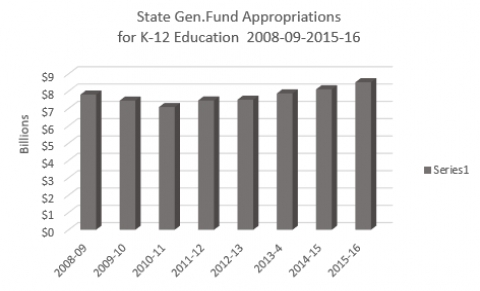Your Basic Needs: Food, Shelter and The TRUTH
The Education Budget: Three Things You Should Know
Publisher's note: This post, by Bob Luebke, was originally published in the Education section of Civitas's online edition.
Those who watch state government have had plenty to talk about since the General Assembly passed the state's new $21.7 billion state budget. Since education is the single largest item in the state budget, here are three things you probably didn't hear about education spending.
The education budget has been increasing. First, contrary to the claims of many educators and the media, the education budget is not declining. General state appropriations for public education (i.e. K-12 education, community colleges and UNC System) have actually increased five years in a row. In fact, over the past five years, state appropriations for all public education have actually increased 14.1 percent, growing from $10.8 billion (current dollars) in 2010-11 to $12.3 billion in 2015-16. This past year, the total budget for public education went up $530 million; including an additional $410 million for K-12 public schools, $99 million more for the UNC System and an additional $20 million for community colleges.

Source: Fiscal Research Division, NC General Assembly
If we focus on the K-12 budget, we see over the past five years the K-12 public school budget has actually increased by 20 percent; rising from $7.085 billion in 2010-11 to $8.516 billion in 2015-16. Of course North Carolina also added almost 45,000 students to K-12 schools as well. Still, the increase in state appropriations is not something that is being reported by many.
Progressives and other education activists make constant reference to millions in budget cuts for public education. How is that possible? It's important to note those claims are based on a budget system which made the continuation of existing services the baseline for future budget decisions. When Republicans gained majorities they switched to a different budget system, one that requires agencies to justify all expenditures; much the opposite of the continuation budget. Suffice it to say, the change has produced a difference of opinion over what constitutes a budget reduction. Most people can readily see, however, if appropriations for a state agency are higher than the previous year, it constitutes a budget increase.
Few NC Lottery dollars finding way to classroom. Second, what is going on with the NC Education Lottery? This year the public schools are expected to receive about $530 million from the NC Education Lottery. While that's a lot of money, what's more important is how the money is being spent. When the lottery was passed in 2006 the plan was to provide additional money in the classroom. And generally, that's how things were divided. In 2010-11, the NC Education Lottery generated about $419 million in revenue for North Carolina public schools. The money was divided as follows: 52% for teacher salaries; 24% school construction; 15% More at Four, 7% College Scholarships; 2% Financial Aid.
This year North Carolina will spend $529 million in lottery revenue divided as follows: non-instructional support personnel 58.5%; pre-kindergarten 14.7%; public school capital fund 18.8%; scholarships 5.7% and UNC Financial Aid 2% (because of rounding numbers may not equal 100 percent).
While the Lottery money has certainly helped the state to cover bills, fund programs and expansions, it's obvious the money is not getting into the classroom. Those hopes seem all but forgotten.
Teacher Retirement and Benefit Costs Increasing. Thirdly and lastly, if we establish that K-12 education funding has increased every year for each of the last five years, and grown $1.5 billion over that time period, where has all the money gone? The short answer to that question is to salaries and retirement. Since 2010, $1.1 billion of the funding increases have been spent on employee salaries and benefits. What has gotten lost in this discussion is the steady rise in retirement benefits and the cost of medical/hospitalization benefits and how those factors are pushing up costs.
Source: NC Department of Public Instruction
The increases are real. In 2008-09, North Carolina state government was paying workers a matching retirement benefit equal to 8.14 percent of salary. In 2015-16 that benefit had increased to 15.32 percent of salary.
The increases have also impacted health care benefits. In 2008-09 North Carolina was paying $4,157 for hospitalization benefits per insured member. In 2015-16 that figure had grown to $5,471, an increase of about 32 percent.
Combined with matching social security benefits (7.65 percent), North Carolina is providing teachers with a benefits package (i.e. social security, retirement and hospitalization) worth over $15,100.
In recent years North Carolina has been putting significant resources into public education, an increase of $1.5 billion in the last five years. Much of the money is being spent on salary increases and the rising costs of retirement benefits. Moreover, revenue we thought would be getting into the classroom — such as revenue from the NC Education Lottery — is not.
Public discussion about the state education budget is healthy. If they include the points raised here, we'll go a long way toward spending our public education dollars wisely, where they can do the most good. The task can't begin too soon.
Go Back
Those who watch state government have had plenty to talk about since the General Assembly passed the state's new $21.7 billion state budget. Since education is the single largest item in the state budget, here are three things you probably didn't hear about education spending.
The education budget has been increasing. First, contrary to the claims of many educators and the media, the education budget is not declining. General state appropriations for public education (i.e. K-12 education, community colleges and UNC System) have actually increased five years in a row. In fact, over the past five years, state appropriations for all public education have actually increased 14.1 percent, growing from $10.8 billion (current dollars) in 2010-11 to $12.3 billion in 2015-16. This past year, the total budget for public education went up $530 million; including an additional $410 million for K-12 public schools, $99 million more for the UNC System and an additional $20 million for community colleges.

Source: Fiscal Research Division, NC General Assembly
If we focus on the K-12 budget, we see over the past five years the K-12 public school budget has actually increased by 20 percent; rising from $7.085 billion in 2010-11 to $8.516 billion in 2015-16. Of course North Carolina also added almost 45,000 students to K-12 schools as well. Still, the increase in state appropriations is not something that is being reported by many.
Progressives and other education activists make constant reference to millions in budget cuts for public education. How is that possible? It's important to note those claims are based on a budget system which made the continuation of existing services the baseline for future budget decisions. When Republicans gained majorities they switched to a different budget system, one that requires agencies to justify all expenditures; much the opposite of the continuation budget. Suffice it to say, the change has produced a difference of opinion over what constitutes a budget reduction. Most people can readily see, however, if appropriations for a state agency are higher than the previous year, it constitutes a budget increase.
Few NC Lottery dollars finding way to classroom. Second, what is going on with the NC Education Lottery? This year the public schools are expected to receive about $530 million from the NC Education Lottery. While that's a lot of money, what's more important is how the money is being spent. When the lottery was passed in 2006 the plan was to provide additional money in the classroom. And generally, that's how things were divided. In 2010-11, the NC Education Lottery generated about $419 million in revenue for North Carolina public schools. The money was divided as follows: 52% for teacher salaries; 24% school construction; 15% More at Four, 7% College Scholarships; 2% Financial Aid.
This year North Carolina will spend $529 million in lottery revenue divided as follows: non-instructional support personnel 58.5%; pre-kindergarten 14.7%; public school capital fund 18.8%; scholarships 5.7% and UNC Financial Aid 2% (because of rounding numbers may not equal 100 percent).
While the Lottery money has certainly helped the state to cover bills, fund programs and expansions, it's obvious the money is not getting into the classroom. Those hopes seem all but forgotten.
Teacher Retirement and Benefit Costs Increasing. Thirdly and lastly, if we establish that K-12 education funding has increased every year for each of the last five years, and grown $1.5 billion over that time period, where has all the money gone? The short answer to that question is to salaries and retirement. Since 2010, $1.1 billion of the funding increases have been spent on employee salaries and benefits. What has gotten lost in this discussion is the steady rise in retirement benefits and the cost of medical/hospitalization benefits and how those factors are pushing up costs.
| Year | Retirement Rate | Health Plan |
| 2008-09 | 8.14% | $4,157 |
| 2009-10 | 8.75% | $4,527 |
| 2010-11 | 10.51% | $4,929 |
| 2011-12 | 13.12% | $4,931 |
| 2012-13 | 14.23% | $5,192 |
| 2013-14 | 14.69% | $5,285 |
| 2014-15 | 15.21% | $5,378 |
| 2015-16 | 15.32% | $5,471 |
The increases are real. In 2008-09, North Carolina state government was paying workers a matching retirement benefit equal to 8.14 percent of salary. In 2015-16 that benefit had increased to 15.32 percent of salary.
The increases have also impacted health care benefits. In 2008-09 North Carolina was paying $4,157 for hospitalization benefits per insured member. In 2015-16 that figure had grown to $5,471, an increase of about 32 percent.
Combined with matching social security benefits (7.65 percent), North Carolina is providing teachers with a benefits package (i.e. social security, retirement and hospitalization) worth over $15,100.
In recent years North Carolina has been putting significant resources into public education, an increase of $1.5 billion in the last five years. Much of the money is being spent on salary increases and the rising costs of retirement benefits. Moreover, revenue we thought would be getting into the classroom — such as revenue from the NC Education Lottery — is not.
Public discussion about the state education budget is healthy. If they include the points raised here, we'll go a long way toward spending our public education dollars wisely, where they can do the most good. The task can't begin too soon.
| NCGA: A win for The Weasels (A blow to the grassroots) | Civitas Institute, Editorials, Op-Ed & Politics | VIDEO: Millennials Will Soon Make Up Largest Chunk Of N.C. Population |
Latest Op-Ed & Politics
|
other pro-terrorist protests in Chicago shout "Death to America" in Farsi
Published: Monday, April 15th, 2024 @ 9:13 pm
By: John Steed
|
|
claim is needed "to meet climate targets
Published: Monday, April 15th, 2024 @ 2:07 pm
By: John Steed
|
|
Only two of the so-called “three Johns” will be competing to replace Sen. Mitch McConnell (R-KY) as leader of the Senate GOP.
Published: Monday, April 15th, 2024 @ 12:50 pm
By: Daily Wire
|
|
particularly true on economic matters
Published: Sunday, April 14th, 2024 @ 8:58 pm
By: John Steed
|
|
House Judiciary Chair Jim Jordan (R-OH) is looking into whether GoFundMe and Eventbrite cooperated with federal law enforcement during their investigation into the financial transactions of supporters of former President Donald Trump.
Published: Sunday, April 14th, 2024 @ 6:56 pm
By: Daily Wire
|
|
Turkish diplomatic sources say he did
Published: Sunday, April 14th, 2024 @ 6:08 pm
By: John Steed
|
|
Popularity of government leader crashes, even among his own party members.
Published: Sunday, April 14th, 2024 @ 2:12 pm
By: John Steed
|






















